Comprehensive Risk Management Plan for Mehfil Restaurant Operations
VerifiedAdded on 2021/07/05
|16
|5894
|36
Report
AI Summary
This report outlines a comprehensive risk management plan designed for Mehfil Restaurant, a business venture selling Indian cuisine. It begins by defining risk and categorizing common business risks such as strategic, compliance, financial, operational, environmental, and reputational risks. The report details the steps involved in developing a risk management plan, including risk identification, assessment, management, and monitoring. It then presents an introduction to Mehfil Restaurant, including its vision, mission, and target market, followed by a stakeholder analysis and identification of critical success factors. The report also references AS/NZ ISO 31000:2009 for risk management guidelines and emphasizes the importance of communication within the organization. Finally, it describes the risk identification process, including the five core steps: risk identification, risk analysis, risk evaluation, risk treatment, and risk monitoring. The report offers insights into how businesses can proactively manage potential threats and minimize their impact.
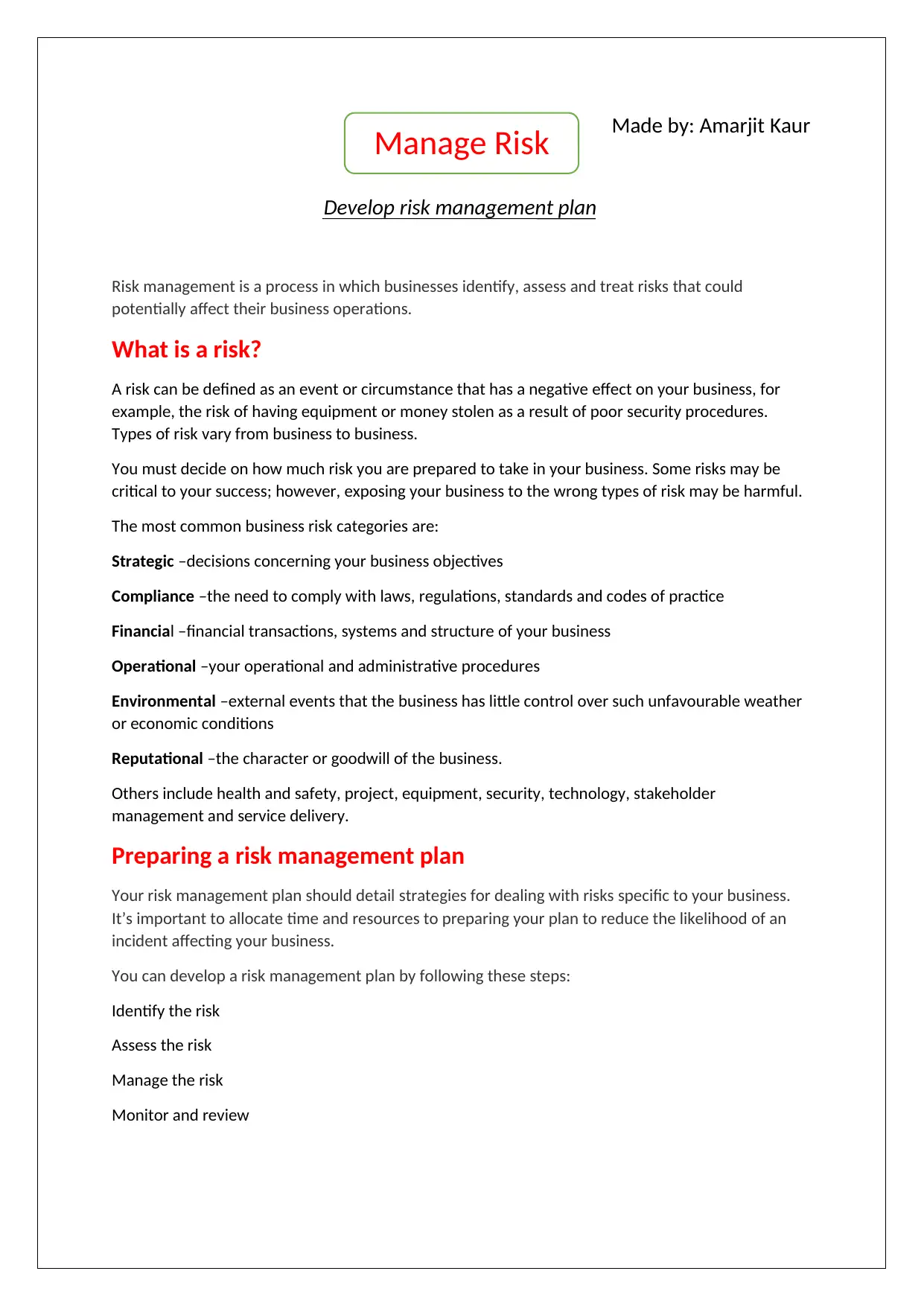
Made by: Amarjit Kaur
Develop risk management plan
Risk management is a process in which businesses identify, assess and treat risks that could
potentially affect their business operations.
What is a risk?
A risk can be defined as an event or circumstance that has a negative effect on your business, for
example, the risk of having equipment or money stolen as a result of poor security procedures.
Types of risk vary from business to business.
You must decide on how much risk you are prepared to take in your business. Some risks may be
critical to your success; however, exposing your business to the wrong types of risk may be harmful.
The most common business risk categories are:
Strategic –decisions concerning your business objectives
Compliance –the need to comply with laws, regulations, standards and codes of practice
Financial –financial transactions, systems and structure of your business
Operational –your operational and administrative procedures
Environmental –external events that the business has little control over such unfavourable weather
or economic conditions
Reputational –the character or goodwill of the business.
Others include health and safety, project, equipment, security, technology, stakeholder
management and service delivery.
Preparing a risk management plan
Your risk management plan should detail strategies for dealing with risks specific to your business.
It’s important to allocate time and resources to preparing your plan to reduce the likelihood of an
incident affecting your business.
You can develop a risk management plan by following these steps:
Identify the risk
Assess the risk
Manage the risk
Monitor and review
Manage Risk
Develop risk management plan
Risk management is a process in which businesses identify, assess and treat risks that could
potentially affect their business operations.
What is a risk?
A risk can be defined as an event or circumstance that has a negative effect on your business, for
example, the risk of having equipment or money stolen as a result of poor security procedures.
Types of risk vary from business to business.
You must decide on how much risk you are prepared to take in your business. Some risks may be
critical to your success; however, exposing your business to the wrong types of risk may be harmful.
The most common business risk categories are:
Strategic –decisions concerning your business objectives
Compliance –the need to comply with laws, regulations, standards and codes of practice
Financial –financial transactions, systems and structure of your business
Operational –your operational and administrative procedures
Environmental –external events that the business has little control over such unfavourable weather
or economic conditions
Reputational –the character or goodwill of the business.
Others include health and safety, project, equipment, security, technology, stakeholder
management and service delivery.
Preparing a risk management plan
Your risk management plan should detail strategies for dealing with risks specific to your business.
It’s important to allocate time and resources to preparing your plan to reduce the likelihood of an
incident affecting your business.
You can develop a risk management plan by following these steps:
Identify the risk
Assess the risk
Manage the risk
Monitor and review
Manage Risk
Paraphrase This Document
Need a fresh take? Get an instant paraphrase of this document with our AI Paraphraser
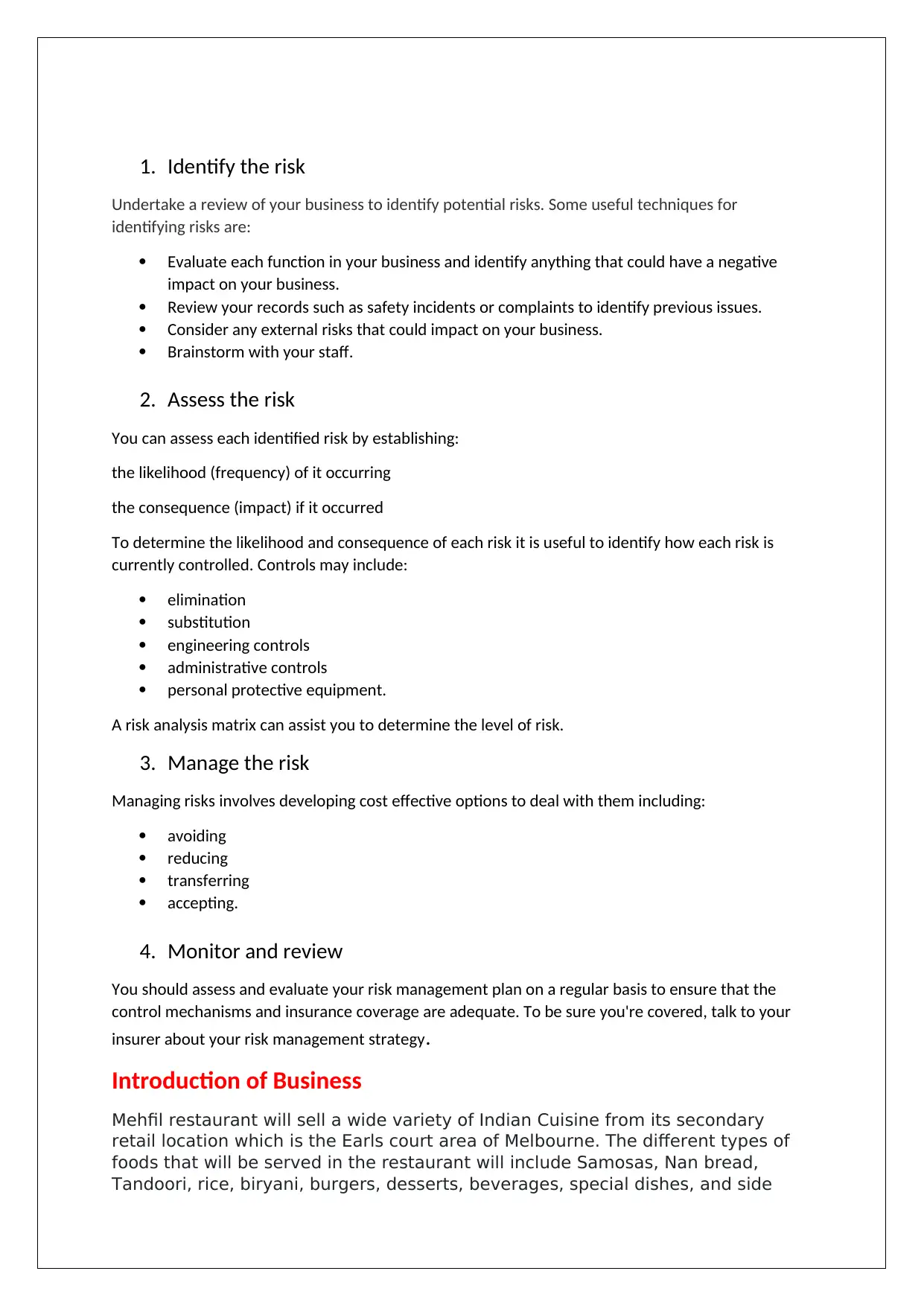
1. Identify the risk
Undertake a review of your business to identify potential risks. Some useful techniques for
identifying risks are:
Evaluate each function in your business and identify anything that could have a negative
impact on your business.
Review your records such as safety incidents or complaints to identify previous issues.
Consider any external risks that could impact on your business.
Brainstorm with your staff.
2. Assess the risk
You can assess each identified risk by establishing:
the likelihood (frequency) of it occurring
the consequence (impact) if it occurred
To determine the likelihood and consequence of each risk it is useful to identify how each risk is
currently controlled. Controls may include:
elimination
substitution
engineering controls
administrative controls
personal protective equipment.
A risk analysis matrix can assist you to determine the level of risk.
3. Manage the risk
Managing risks involves developing cost effective options to deal with them including:
avoiding
reducing
transferring
accepting.
4. Monitor and review
You should assess and evaluate your risk management plan on a regular basis to ensure that the
control mechanisms and insurance coverage are adequate. To be sure you're covered, talk to your
insurer about your risk management strategy.
Introduction of Business
Mehfil restaurant will sell a wide variety of Indian Cuisine from its secondary
retail location which is the Earls court area of Melbourne. The different types of
foods that will be served in the restaurant will include Samosas, Nan bread,
Tandoori, rice, biryani, burgers, desserts, beverages, special dishes, and side
Undertake a review of your business to identify potential risks. Some useful techniques for
identifying risks are:
Evaluate each function in your business and identify anything that could have a negative
impact on your business.
Review your records such as safety incidents or complaints to identify previous issues.
Consider any external risks that could impact on your business.
Brainstorm with your staff.
2. Assess the risk
You can assess each identified risk by establishing:
the likelihood (frequency) of it occurring
the consequence (impact) if it occurred
To determine the likelihood and consequence of each risk it is useful to identify how each risk is
currently controlled. Controls may include:
elimination
substitution
engineering controls
administrative controls
personal protective equipment.
A risk analysis matrix can assist you to determine the level of risk.
3. Manage the risk
Managing risks involves developing cost effective options to deal with them including:
avoiding
reducing
transferring
accepting.
4. Monitor and review
You should assess and evaluate your risk management plan on a regular basis to ensure that the
control mechanisms and insurance coverage are adequate. To be sure you're covered, talk to your
insurer about your risk management strategy.
Introduction of Business
Mehfil restaurant will sell a wide variety of Indian Cuisine from its secondary
retail location which is the Earls court area of Melbourne. The different types of
foods that will be served in the restaurant will include Samosas, Nan bread,
Tandoori, rice, biryani, burgers, desserts, beverages, special dishes, and side
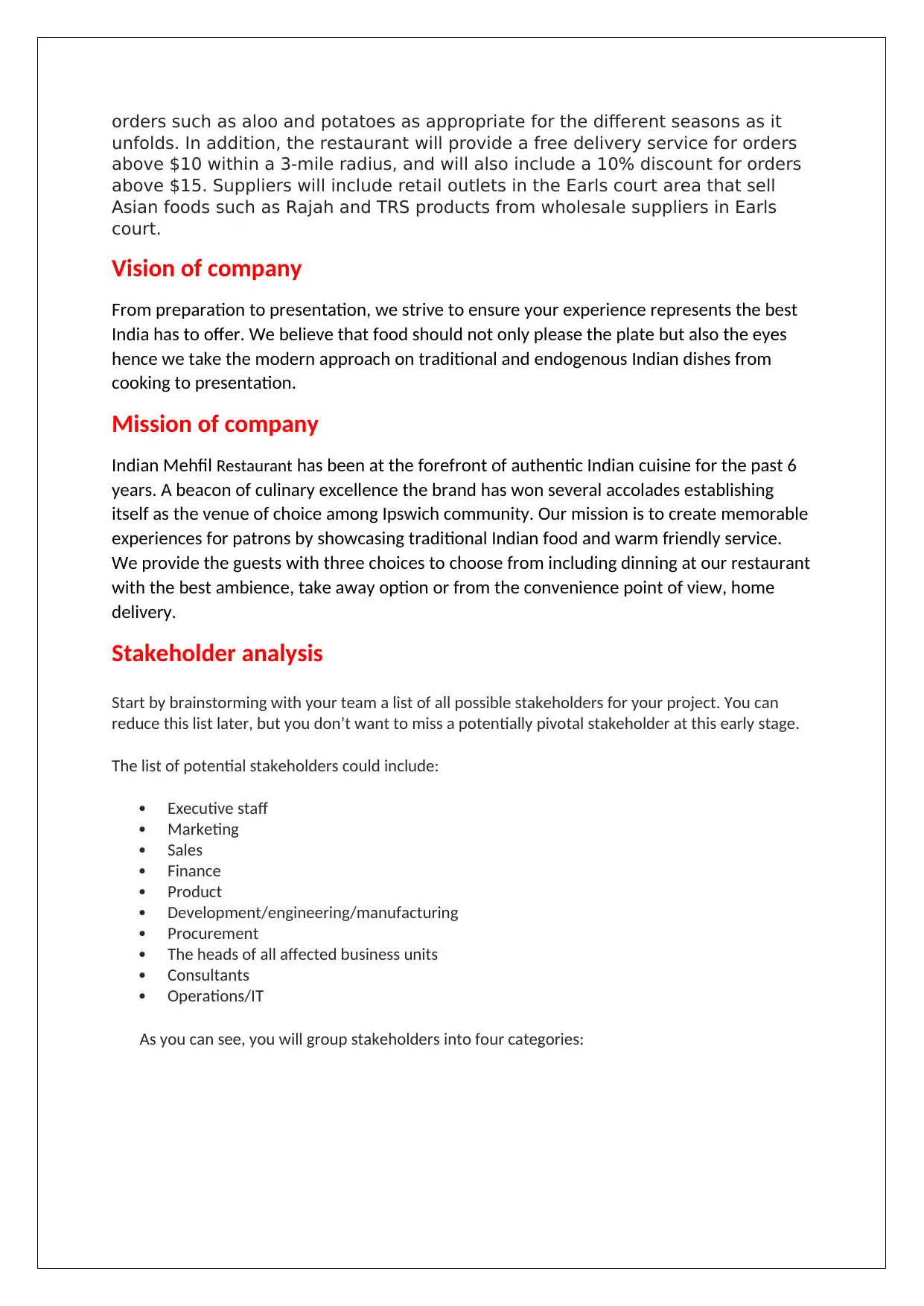
orders such as aloo and potatoes as appropriate for the different seasons as it
unfolds. In addition, the restaurant will provide a free delivery service for orders
above $10 within a 3-mile radius, and will also include a 10% discount for orders
above $15. Suppliers will include retail outlets in the Earls court area that sell
Asian foods such as Rajah and TRS products from wholesale suppliers in Earls
court.
Vision of company
From preparation to presentation, we strive to ensure your experience represents the best
India has to offer. We believe that food should not only please the plate but also the eyes
hence we take the modern approach on traditional and endogenous Indian dishes from
cooking to presentation.
Mission of company
Indian Mehfil Restaurant has been at the forefront of authentic Indian cuisine for the past 6
years. A beacon of culinary excellence the brand has won several accolades establishing
itself as the venue of choice among Ipswich community. Our mission is to create memorable
experiences for patrons by showcasing traditional Indian food and warm friendly service.
We provide the guests with three choices to choose from including dinning at our restaurant
with the best ambience, take away option or from the convenience point of view, home
delivery.
Stakeholder analysis
Start by brainstorming with your team a list of all possible stakeholders for your project. You can
reduce this list later, but you don’t want to miss a potentially pivotal stakeholder at this early stage.
The list of potential stakeholders could include:
Executive staff
Marketing
Sales
Finance
Product
Development/engineering/manufacturing
Procurement
The heads of all affected business units
Consultants
Operations/IT
As you can see, you will group stakeholders into four categories:
unfolds. In addition, the restaurant will provide a free delivery service for orders
above $10 within a 3-mile radius, and will also include a 10% discount for orders
above $15. Suppliers will include retail outlets in the Earls court area that sell
Asian foods such as Rajah and TRS products from wholesale suppliers in Earls
court.
Vision of company
From preparation to presentation, we strive to ensure your experience represents the best
India has to offer. We believe that food should not only please the plate but also the eyes
hence we take the modern approach on traditional and endogenous Indian dishes from
cooking to presentation.
Mission of company
Indian Mehfil Restaurant has been at the forefront of authentic Indian cuisine for the past 6
years. A beacon of culinary excellence the brand has won several accolades establishing
itself as the venue of choice among Ipswich community. Our mission is to create memorable
experiences for patrons by showcasing traditional Indian food and warm friendly service.
We provide the guests with three choices to choose from including dinning at our restaurant
with the best ambience, take away option or from the convenience point of view, home
delivery.
Stakeholder analysis
Start by brainstorming with your team a list of all possible stakeholders for your project. You can
reduce this list later, but you don’t want to miss a potentially pivotal stakeholder at this early stage.
The list of potential stakeholders could include:
Executive staff
Marketing
Sales
Finance
Product
Development/engineering/manufacturing
Procurement
The heads of all affected business units
Consultants
Operations/IT
As you can see, you will group stakeholders into four categories:
⊘ This is a preview!⊘
Do you want full access?
Subscribe today to unlock all pages.

Trusted by 1+ million students worldwide
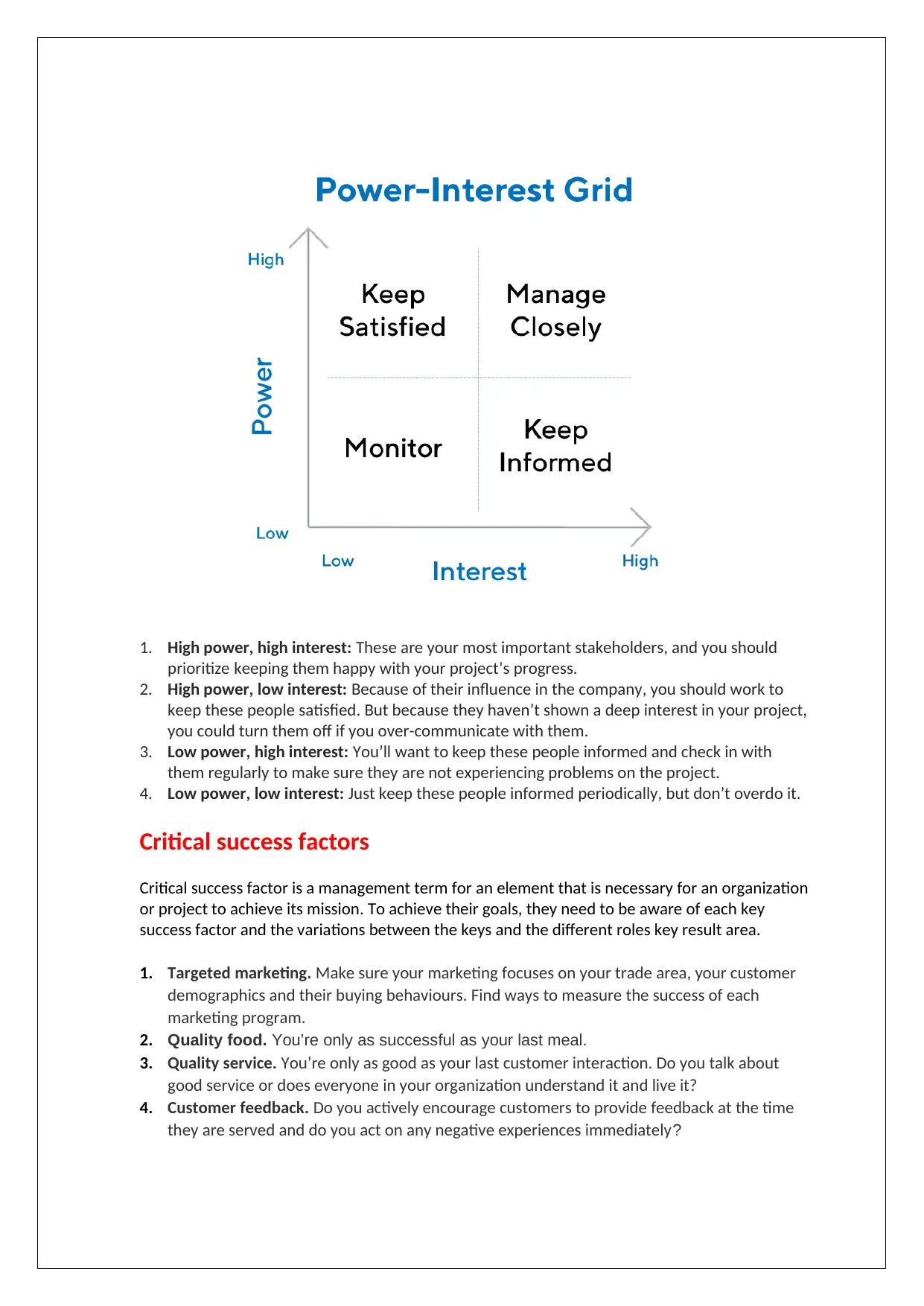
1. High power, high interest: These are your most important stakeholders, and you should
prioritize keeping them happy with your project’s progress.
2. High power, low interest: Because of their influence in the company, you should work to
keep these people satisfied. But because they haven’t shown a deep interest in your project,
you could turn them off if you over-communicate with them.
3. Low power, high interest: You’ll want to keep these people informed and check in with
them regularly to make sure they are not experiencing problems on the project.
4. Low power, low interest: Just keep these people informed periodically, but don’t overdo it.
Critical success factors
Critical success factor is a management term for an element that is necessary for an organization
or project to achieve its mission. To achieve their goals, they need to be aware of each key
success factor and the variations between the keys and the different roles key result area.
1. Targeted marketing. Make sure your marketing focuses on your trade area, your customer
demographics and their buying behaviours. Find ways to measure the success of each
marketing program.
2. Quality food. You’re only as successful as your last meal.
3. Quality service. You’re only as good as your last customer interaction. Do you talk about
good service or does everyone in your organization understand it and live it?
4. Customer feedback. Do you actively encourage customers to provide feedback at the time
they are served and do you act on any negative experiences immediately?
prioritize keeping them happy with your project’s progress.
2. High power, low interest: Because of their influence in the company, you should work to
keep these people satisfied. But because they haven’t shown a deep interest in your project,
you could turn them off if you over-communicate with them.
3. Low power, high interest: You’ll want to keep these people informed and check in with
them regularly to make sure they are not experiencing problems on the project.
4. Low power, low interest: Just keep these people informed periodically, but don’t overdo it.
Critical success factors
Critical success factor is a management term for an element that is necessary for an organization
or project to achieve its mission. To achieve their goals, they need to be aware of each key
success factor and the variations between the keys and the different roles key result area.
1. Targeted marketing. Make sure your marketing focuses on your trade area, your customer
demographics and their buying behaviours. Find ways to measure the success of each
marketing program.
2. Quality food. You’re only as successful as your last meal.
3. Quality service. You’re only as good as your last customer interaction. Do you talk about
good service or does everyone in your organization understand it and live it?
4. Customer feedback. Do you actively encourage customers to provide feedback at the time
they are served and do you act on any negative experiences immediately?
Paraphrase This Document
Need a fresh take? Get an instant paraphrase of this document with our AI Paraphraser
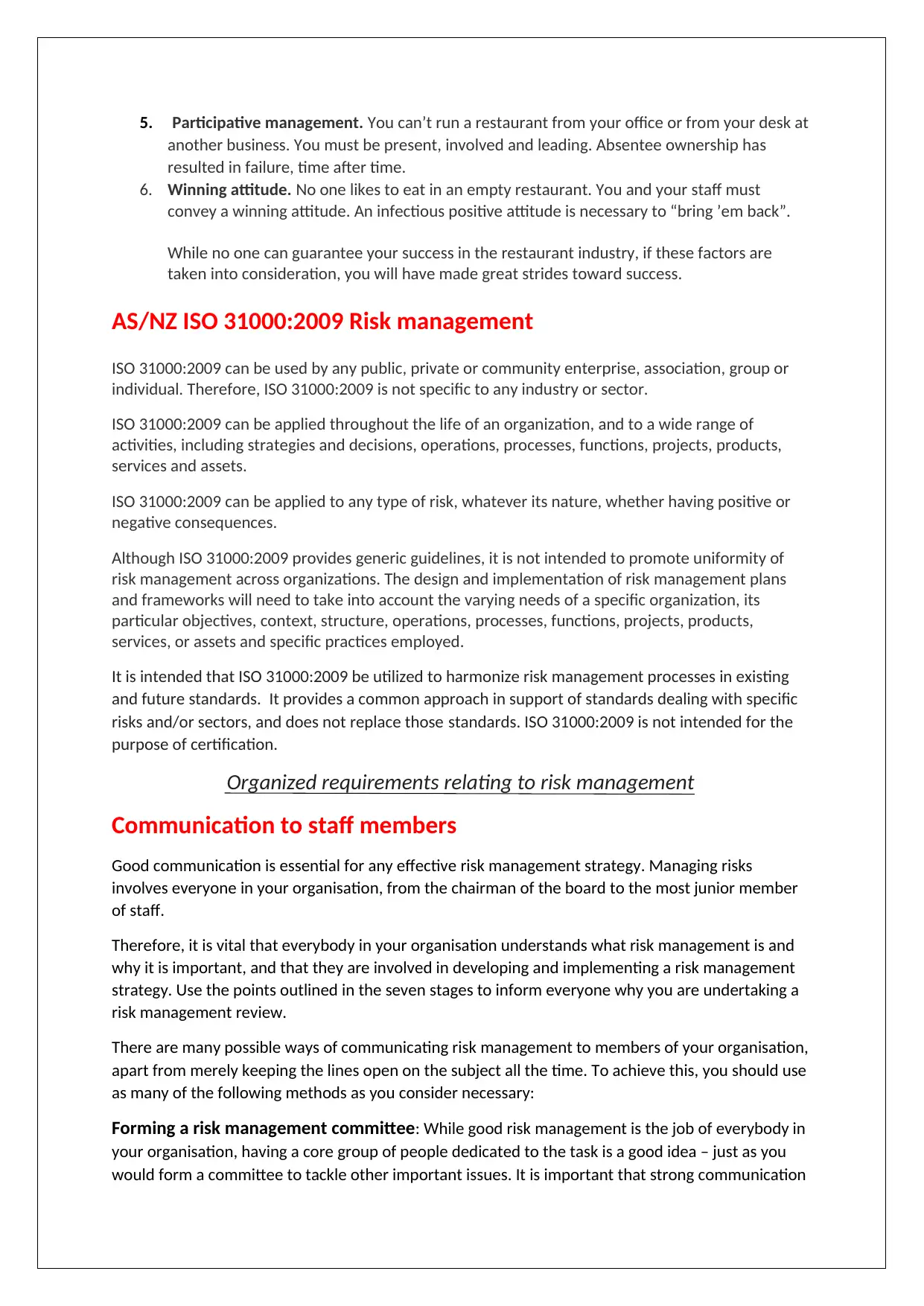
5. Participative management. You can’t run a restaurant from your office or from your desk at
another business. You must be present, involved and leading. Absentee ownership has
resulted in failure, time after time.
6. Winning attitude. No one likes to eat in an empty restaurant. You and your staff must
convey a winning attitude. An infectious positive attitude is necessary to “bring ’em back”.
While no one can guarantee your success in the restaurant industry, if these factors are
taken into consideration, you will have made great strides toward success.
AS/NZ ISO 31000:2009 Risk management
ISO 31000:2009 can be used by any public, private or community enterprise, association, group or
individual. Therefore, ISO 31000:2009 is not specific to any industry or sector.
ISO 31000:2009 can be applied throughout the life of an organization, and to a wide range of
activities, including strategies and decisions, operations, processes, functions, projects, products,
services and assets.
ISO 31000:2009 can be applied to any type of risk, whatever its nature, whether having positive or
negative consequences.
Although ISO 31000:2009 provides generic guidelines, it is not intended to promote uniformity of
risk management across organizations. The design and implementation of risk management plans
and frameworks will need to take into account the varying needs of a specific organization, its
particular objectives, context, structure, operations, processes, functions, projects, products,
services, or assets and specific practices employed.
It is intended that ISO 31000:2009 be utilized to harmonize risk management processes in existing
and future standards. It provides a common approach in support of standards dealing with specific
risks and/or sectors, and does not replace those standards. ISO 31000:2009 is not intended for the
purpose of certification.
Organized requirements relating to risk management
Communication to staff members
Good communication is essential for any effective risk management strategy. Managing risks
involves everyone in your organisation, from the chairman of the board to the most junior member
of staff.
Therefore, it is vital that everybody in your organisation understands what risk management is and
why it is important, and that they are involved in developing and implementing a risk management
strategy. Use the points outlined in the seven stages to inform everyone why you are undertaking a
risk management review.
There are many possible ways of communicating risk management to members of your organisation,
apart from merely keeping the lines open on the subject all the time. To achieve this, you should use
as many of the following methods as you consider necessary:
Forming a risk management committee: While good risk management is the job of everybody in
your organisation, having a core group of people dedicated to the task is a good idea – just as you
would form a committee to tackle other important issues. It is important that strong communication
another business. You must be present, involved and leading. Absentee ownership has
resulted in failure, time after time.
6. Winning attitude. No one likes to eat in an empty restaurant. You and your staff must
convey a winning attitude. An infectious positive attitude is necessary to “bring ’em back”.
While no one can guarantee your success in the restaurant industry, if these factors are
taken into consideration, you will have made great strides toward success.
AS/NZ ISO 31000:2009 Risk management
ISO 31000:2009 can be used by any public, private or community enterprise, association, group or
individual. Therefore, ISO 31000:2009 is not specific to any industry or sector.
ISO 31000:2009 can be applied throughout the life of an organization, and to a wide range of
activities, including strategies and decisions, operations, processes, functions, projects, products,
services and assets.
ISO 31000:2009 can be applied to any type of risk, whatever its nature, whether having positive or
negative consequences.
Although ISO 31000:2009 provides generic guidelines, it is not intended to promote uniformity of
risk management across organizations. The design and implementation of risk management plans
and frameworks will need to take into account the varying needs of a specific organization, its
particular objectives, context, structure, operations, processes, functions, projects, products,
services, or assets and specific practices employed.
It is intended that ISO 31000:2009 be utilized to harmonize risk management processes in existing
and future standards. It provides a common approach in support of standards dealing with specific
risks and/or sectors, and does not replace those standards. ISO 31000:2009 is not intended for the
purpose of certification.
Organized requirements relating to risk management
Communication to staff members
Good communication is essential for any effective risk management strategy. Managing risks
involves everyone in your organisation, from the chairman of the board to the most junior member
of staff.
Therefore, it is vital that everybody in your organisation understands what risk management is and
why it is important, and that they are involved in developing and implementing a risk management
strategy. Use the points outlined in the seven stages to inform everyone why you are undertaking a
risk management review.
There are many possible ways of communicating risk management to members of your organisation,
apart from merely keeping the lines open on the subject all the time. To achieve this, you should use
as many of the following methods as you consider necessary:
Forming a risk management committee: While good risk management is the job of everybody in
your organisation, having a core group of people dedicated to the task is a good idea – just as you
would form a committee to tackle other important issues. It is important that strong communication
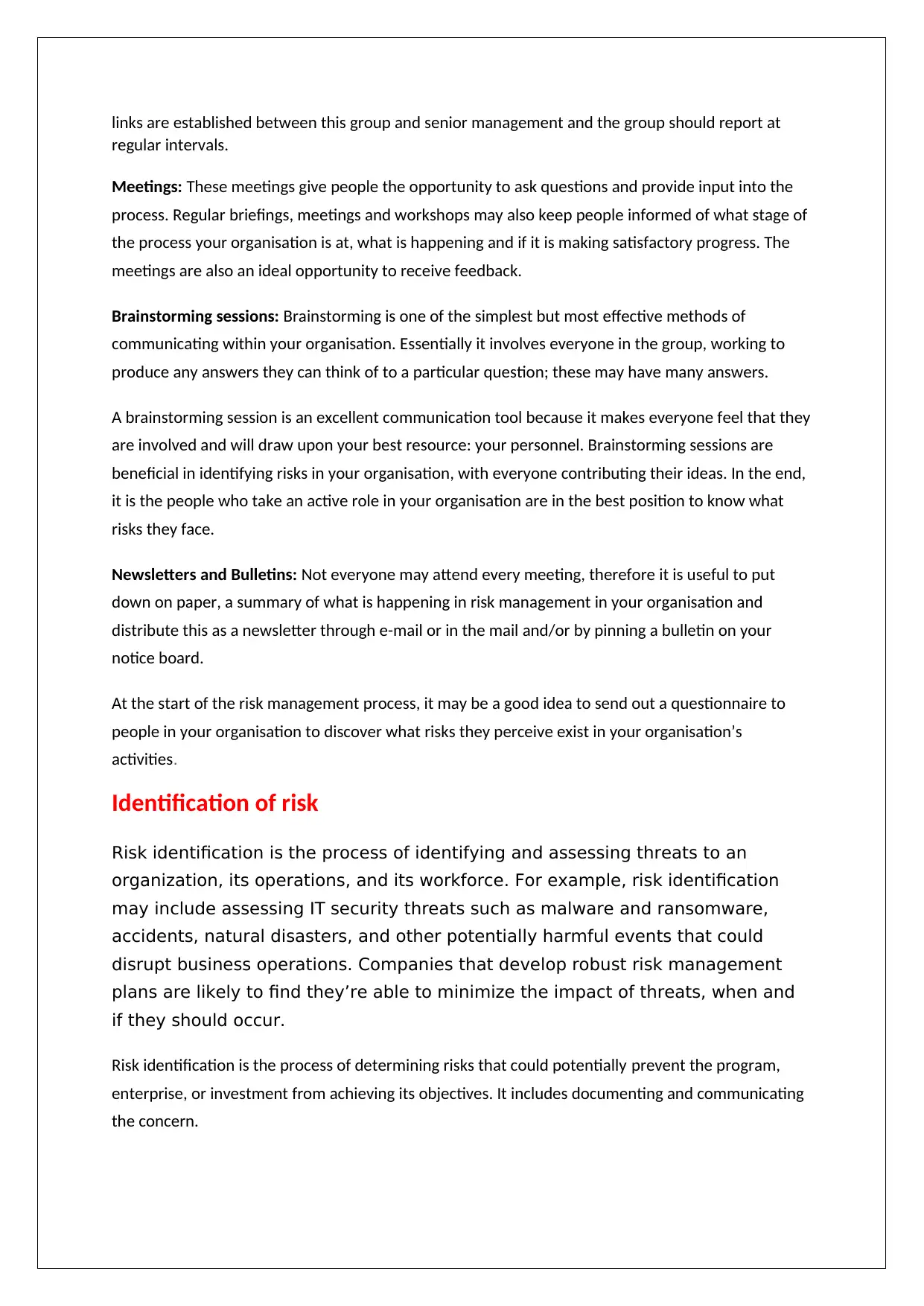
links are established between this group and senior management and the group should report at
regular intervals.
Meetings: These meetings give people the opportunity to ask questions and provide input into the
process. Regular briefings, meetings and workshops may also keep people informed of what stage of
the process your organisation is at, what is happening and if it is making satisfactory progress. The
meetings are also an ideal opportunity to receive feedback.
Brainstorming sessions: Brainstorming is one of the simplest but most effective methods of
communicating within your organisation. Essentially it involves everyone in the group, working to
produce any answers they can think of to a particular question; these may have many answers.
A brainstorming session is an excellent communication tool because it makes everyone feel that they
are involved and will draw upon your best resource: your personnel. Brainstorming sessions are
beneficial in identifying risks in your organisation, with everyone contributing their ideas. In the end,
it is the people who take an active role in your organisation are in the best position to know what
risks they face.
Newsletters and Bulletins: Not everyone may attend every meeting, therefore it is useful to put
down on paper, a summary of what is happening in risk management in your organisation and
distribute this as a newsletter through e-mail or in the mail and/or by pinning a bulletin on your
notice board.
At the start of the risk management process, it may be a good idea to send out a questionnaire to
people in your organisation to discover what risks they perceive exist in your organisation’s
activities.
Identification of risk
Risk identification is the process of identifying and assessing threats to an
organization, its operations, and its workforce. For example, risk identification
may include assessing IT security threats such as malware and ransomware,
accidents, natural disasters, and other potentially harmful events that could
disrupt business operations. Companies that develop robust risk management
plans are likely to find they’re able to minimize the impact of threats, when and
if they should occur.
Risk identification is the process of determining risks that could potentially prevent the program,
enterprise, or investment from achieving its objectives. It includes documenting and communicating
the concern.
regular intervals.
Meetings: These meetings give people the opportunity to ask questions and provide input into the
process. Regular briefings, meetings and workshops may also keep people informed of what stage of
the process your organisation is at, what is happening and if it is making satisfactory progress. The
meetings are also an ideal opportunity to receive feedback.
Brainstorming sessions: Brainstorming is one of the simplest but most effective methods of
communicating within your organisation. Essentially it involves everyone in the group, working to
produce any answers they can think of to a particular question; these may have many answers.
A brainstorming session is an excellent communication tool because it makes everyone feel that they
are involved and will draw upon your best resource: your personnel. Brainstorming sessions are
beneficial in identifying risks in your organisation, with everyone contributing their ideas. In the end,
it is the people who take an active role in your organisation are in the best position to know what
risks they face.
Newsletters and Bulletins: Not everyone may attend every meeting, therefore it is useful to put
down on paper, a summary of what is happening in risk management in your organisation and
distribute this as a newsletter through e-mail or in the mail and/or by pinning a bulletin on your
notice board.
At the start of the risk management process, it may be a good idea to send out a questionnaire to
people in your organisation to discover what risks they perceive exist in your organisation’s
activities.
Identification of risk
Risk identification is the process of identifying and assessing threats to an
organization, its operations, and its workforce. For example, risk identification
may include assessing IT security threats such as malware and ransomware,
accidents, natural disasters, and other potentially harmful events that could
disrupt business operations. Companies that develop robust risk management
plans are likely to find they’re able to minimize the impact of threats, when and
if they should occur.
Risk identification is the process of determining risks that could potentially prevent the program,
enterprise, or investment from achieving its objectives. It includes documenting and communicating
the concern.
⊘ This is a preview!⊘
Do you want full access?
Subscribe today to unlock all pages.

Trusted by 1+ million students worldwide
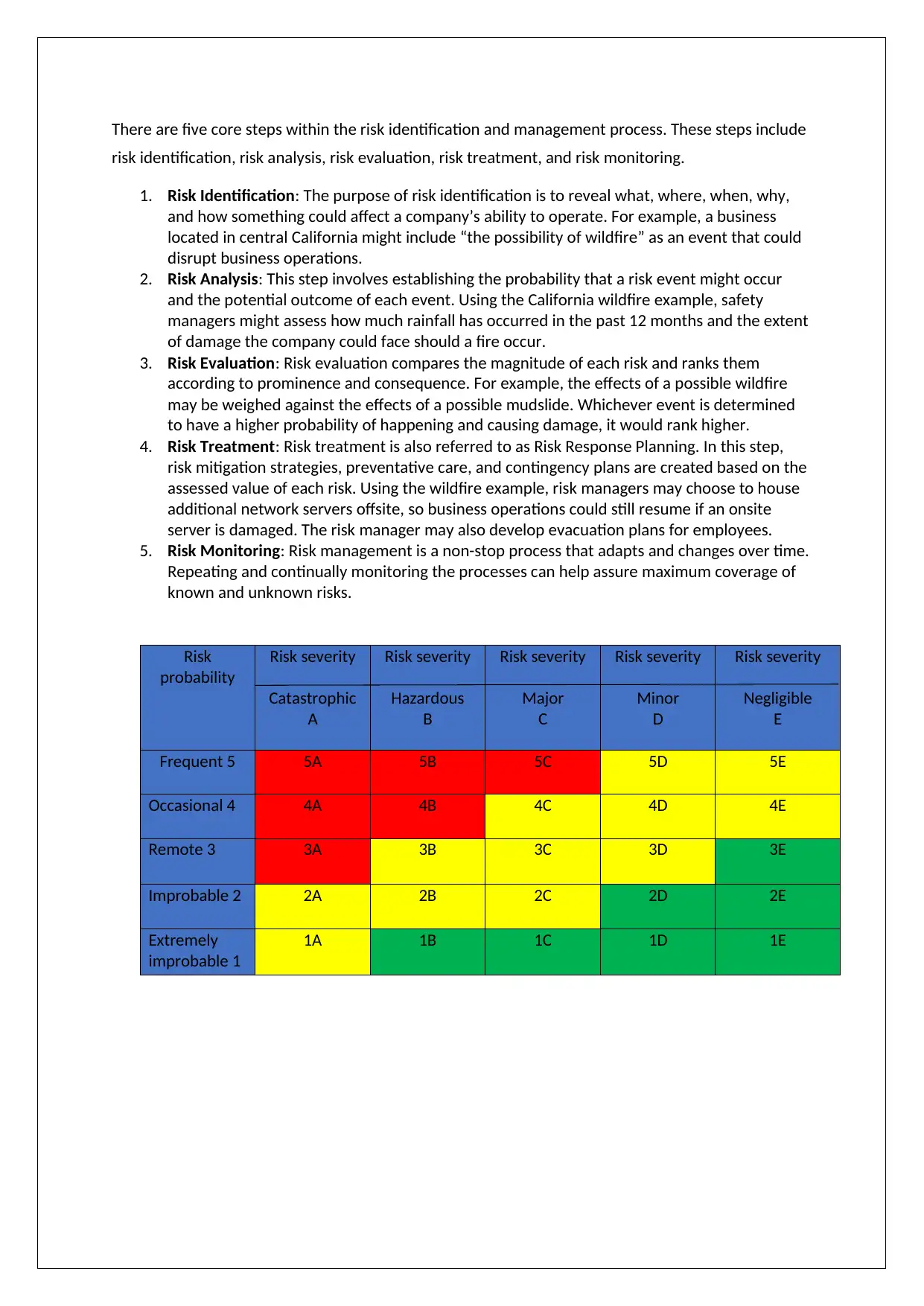
There are five core steps within the risk identification and management process. These steps include
risk identification, risk analysis, risk evaluation, risk treatment, and risk monitoring.
1. Risk Identification: The purpose of risk identification is to reveal what, where, when, why,
and how something could affect a company’s ability to operate. For example, a business
located in central California might include “the possibility of wildfire” as an event that could
disrupt business operations.
2. Risk Analysis: This step involves establishing the probability that a risk event might occur
and the potential outcome of each event. Using the California wildfire example, safety
managers might assess how much rainfall has occurred in the past 12 months and the extent
of damage the company could face should a fire occur.
3. Risk Evaluation: Risk evaluation compares the magnitude of each risk and ranks them
according to prominence and consequence. For example, the effects of a possible wildfire
may be weighed against the effects of a possible mudslide. Whichever event is determined
to have a higher probability of happening and causing damage, it would rank higher.
4. Risk Treatment: Risk treatment is also referred to as Risk Response Planning. In this step,
risk mitigation strategies, preventative care, and contingency plans are created based on the
assessed value of each risk. Using the wildfire example, risk managers may choose to house
additional network servers offsite, so business operations could still resume if an onsite
server is damaged. The risk manager may also develop evacuation plans for employees.
5. Risk Monitoring: Risk management is a non-stop process that adapts and changes over time.
Repeating and continually monitoring the processes can help assure maximum coverage of
known and unknown risks.
Risk
probability
Risk severity
Catastrophic
A
Risk severity
Hazardous
B
Risk severity
Major
C
Risk severity
Minor
D
Risk severity
Negligible
E
Frequent 5 5A 5B 5C 5D 5E
Occasional 4 4A 4B 4C 4D 4E
Remote 3 3A 3B 3C 3D 3E
Improbable 2 2A 2B 2C 2D 2E
Extremely
improbable 1
1A 1B 1C 1D 1E
risk identification, risk analysis, risk evaluation, risk treatment, and risk monitoring.
1. Risk Identification: The purpose of risk identification is to reveal what, where, when, why,
and how something could affect a company’s ability to operate. For example, a business
located in central California might include “the possibility of wildfire” as an event that could
disrupt business operations.
2. Risk Analysis: This step involves establishing the probability that a risk event might occur
and the potential outcome of each event. Using the California wildfire example, safety
managers might assess how much rainfall has occurred in the past 12 months and the extent
of damage the company could face should a fire occur.
3. Risk Evaluation: Risk evaluation compares the magnitude of each risk and ranks them
according to prominence and consequence. For example, the effects of a possible wildfire
may be weighed against the effects of a possible mudslide. Whichever event is determined
to have a higher probability of happening and causing damage, it would rank higher.
4. Risk Treatment: Risk treatment is also referred to as Risk Response Planning. In this step,
risk mitigation strategies, preventative care, and contingency plans are created based on the
assessed value of each risk. Using the wildfire example, risk managers may choose to house
additional network servers offsite, so business operations could still resume if an onsite
server is damaged. The risk manager may also develop evacuation plans for employees.
5. Risk Monitoring: Risk management is a non-stop process that adapts and changes over time.
Repeating and continually monitoring the processes can help assure maximum coverage of
known and unknown risks.
Risk
probability
Risk severity
Catastrophic
A
Risk severity
Hazardous
B
Risk severity
Major
C
Risk severity
Minor
D
Risk severity
Negligible
E
Frequent 5 5A 5B 5C 5D 5E
Occasional 4 4A 4B 4C 4D 4E
Remote 3 3A 3B 3C 3D 3E
Improbable 2 2A 2B 2C 2D 2E
Extremely
improbable 1
1A 1B 1C 1D 1E
Paraphrase This Document
Need a fresh take? Get an instant paraphrase of this document with our AI Paraphraser
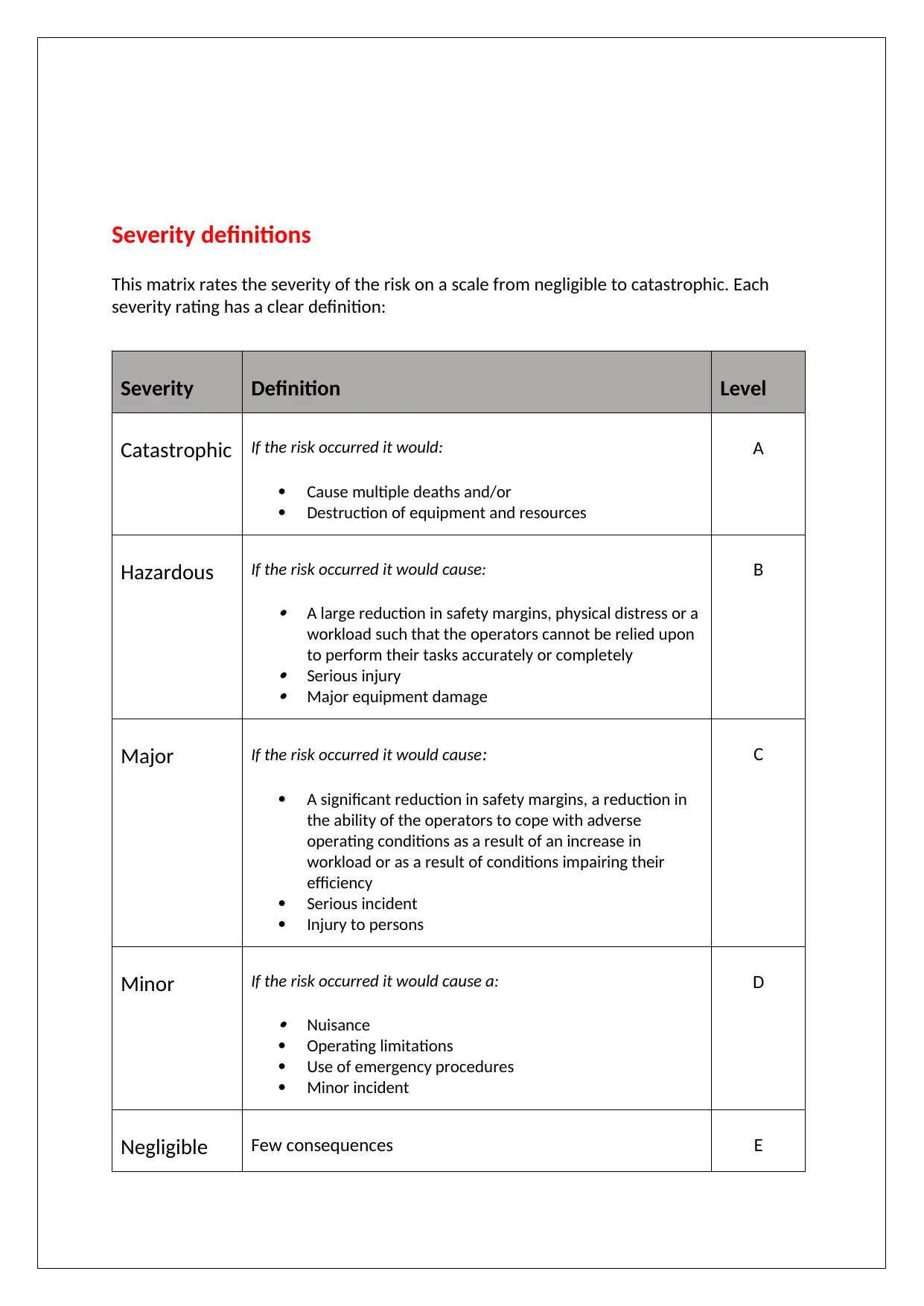
Severity definitions
This matrix rates the severity of the risk on a scale from negligible to catastrophic. Each
severity rating has a clear definition:
Severity Definition Level
Catastrophic If the risk occurred it would:
Cause multiple deaths and/or
Destruction of equipment and resources
A
Hazardous If the risk occurred it would cause:
A large reduction in safety margins, physical distress or a
workload such that the operators cannot be relied upon
to perform their tasks accurately or completely
Serious injury
Major equipment damage
B
Major If the risk occurred it would cause:
A significant reduction in safety margins, a reduction in
the ability of the operators to cope with adverse
operating conditions as a result of an increase in
workload or as a result of conditions impairing their
efficiency
Serious incident
Injury to persons
C
Minor If the risk occurred it would cause a:
Nuisance
Operating limitations
Use of emergency procedures
Minor incident
D
Negligible Few consequences E
This matrix rates the severity of the risk on a scale from negligible to catastrophic. Each
severity rating has a clear definition:
Severity Definition Level
Catastrophic If the risk occurred it would:
Cause multiple deaths and/or
Destruction of equipment and resources
A
Hazardous If the risk occurred it would cause:
A large reduction in safety margins, physical distress or a
workload such that the operators cannot be relied upon
to perform their tasks accurately or completely
Serious injury
Major equipment damage
B
Major If the risk occurred it would cause:
A significant reduction in safety margins, a reduction in
the ability of the operators to cope with adverse
operating conditions as a result of an increase in
workload or as a result of conditions impairing their
efficiency
Serious incident
Injury to persons
C
Minor If the risk occurred it would cause a:
Nuisance
Operating limitations
Use of emergency procedures
Minor incident
D
Negligible Few consequences E
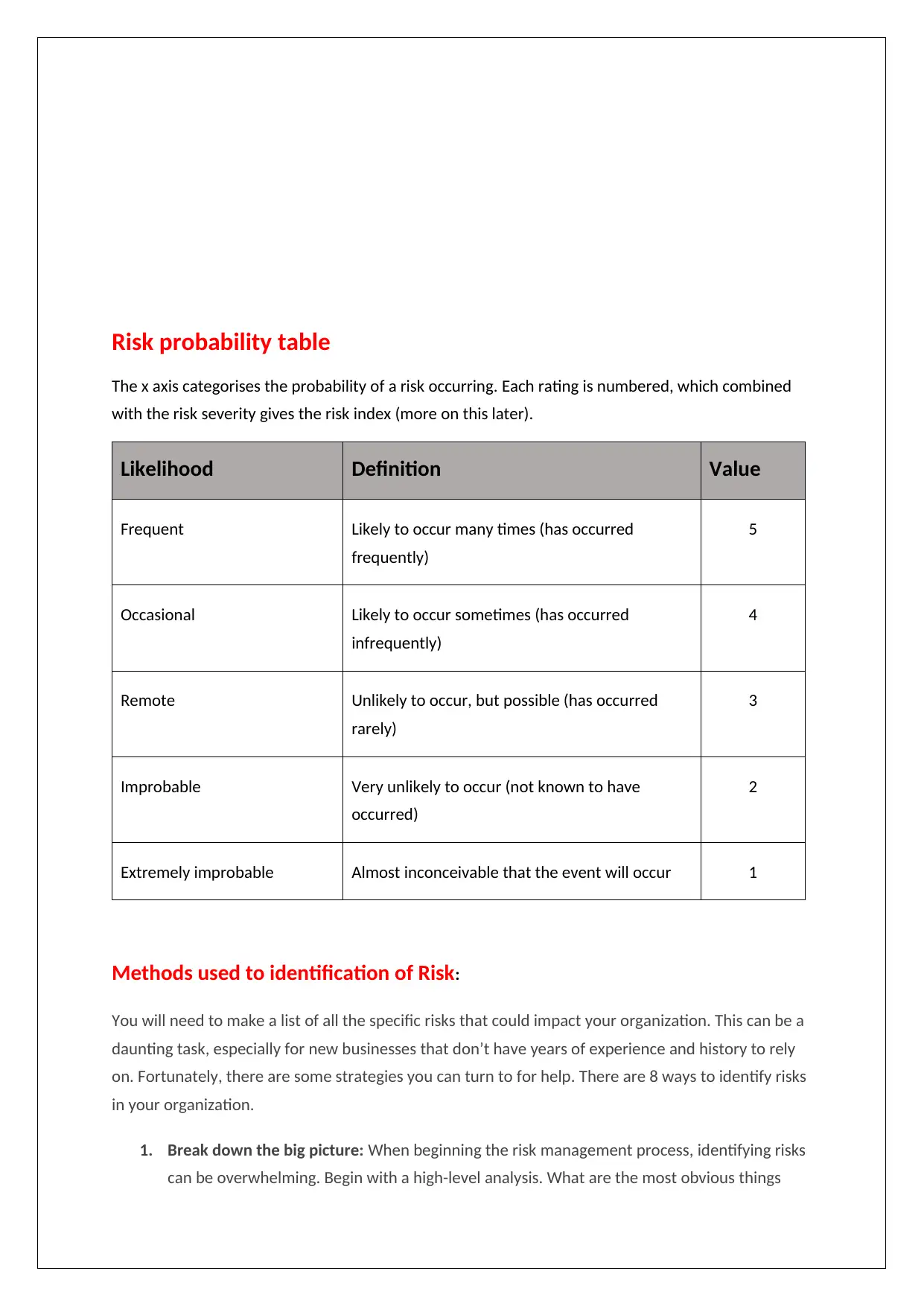
Risk probability table
The x axis categorises the probability of a risk occurring. Each rating is numbered, which combined
with the risk severity gives the risk index (more on this later).
Likelihood Definition Value
Frequent Likely to occur many times (has occurred
frequently)
5
Occasional Likely to occur sometimes (has occurred
infrequently)
4
Remote Unlikely to occur, but possible (has occurred
rarely)
3
Improbable Very unlikely to occur (not known to have
occurred)
2
Extremely improbable Almost inconceivable that the event will occur 1
Methods used to identification of Risk:
You will need to make a list of all the specific risks that could impact your organization. This can be a
daunting task, especially for new businesses that don’t have years of experience and history to rely
on. Fortunately, there are some strategies you can turn to for help. There are 8 ways to identify risks
in your organization.
1. Break down the big picture: When beginning the risk management process, identifying risks
can be overwhelming. Begin with a high-level analysis. What are the most obvious things
The x axis categorises the probability of a risk occurring. Each rating is numbered, which combined
with the risk severity gives the risk index (more on this later).
Likelihood Definition Value
Frequent Likely to occur many times (has occurred
frequently)
5
Occasional Likely to occur sometimes (has occurred
infrequently)
4
Remote Unlikely to occur, but possible (has occurred
rarely)
3
Improbable Very unlikely to occur (not known to have
occurred)
2
Extremely improbable Almost inconceivable that the event will occur 1
Methods used to identification of Risk:
You will need to make a list of all the specific risks that could impact your organization. This can be a
daunting task, especially for new businesses that don’t have years of experience and history to rely
on. Fortunately, there are some strategies you can turn to for help. There are 8 ways to identify risks
in your organization.
1. Break down the big picture: When beginning the risk management process, identifying risks
can be overwhelming. Begin with a high-level analysis. What are the most obvious things
⊘ This is a preview!⊘
Do you want full access?
Subscribe today to unlock all pages.

Trusted by 1+ million students worldwide
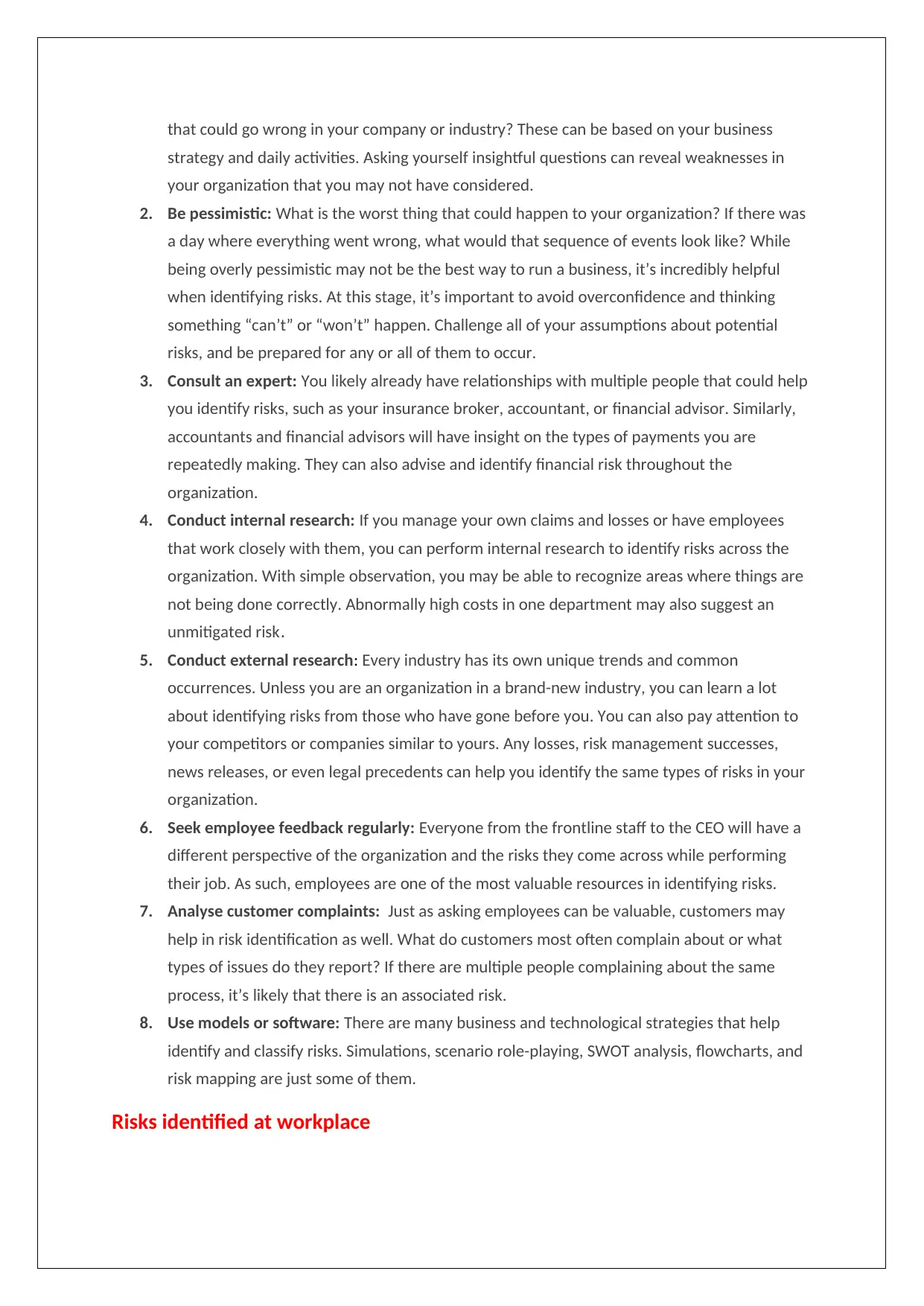
that could go wrong in your company or industry? These can be based on your business
strategy and daily activities. Asking yourself insightful questions can reveal weaknesses in
your organization that you may not have considered.
2. Be pessimistic: What is the worst thing that could happen to your organization? If there was
a day where everything went wrong, what would that sequence of events look like? While
being overly pessimistic may not be the best way to run a business, it’s incredibly helpful
when identifying risks. At this stage, it’s important to avoid overconfidence and thinking
something “can’t” or “won’t” happen. Challenge all of your assumptions about potential
risks, and be prepared for any or all of them to occur.
3. Consult an expert: You likely already have relationships with multiple people that could help
you identify risks, such as your insurance broker, accountant, or financial advisor. Similarly,
accountants and financial advisors will have insight on the types of payments you are
repeatedly making. They can also advise and identify financial risk throughout the
organization.
4. Conduct internal research: If you manage your own claims and losses or have employees
that work closely with them, you can perform internal research to identify risks across the
organization. With simple observation, you may be able to recognize areas where things are
not being done correctly. Abnormally high costs in one department may also suggest an
unmitigated risk.
5. Conduct external research: Every industry has its own unique trends and common
occurrences. Unless you are an organization in a brand-new industry, you can learn a lot
about identifying risks from those who have gone before you. You can also pay attention to
your competitors or companies similar to yours. Any losses, risk management successes,
news releases, or even legal precedents can help you identify the same types of risks in your
organization.
6. Seek employee feedback regularly: Everyone from the frontline staff to the CEO will have a
different perspective of the organization and the risks they come across while performing
their job. As such, employees are one of the most valuable resources in identifying risks.
7. Analyse customer complaints: Just as asking employees can be valuable, customers may
help in risk identification as well. What do customers most often complain about or what
types of issues do they report? If there are multiple people complaining about the same
process, it’s likely that there is an associated risk.
8. Use models or software: There are many business and technological strategies that help
identify and classify risks. Simulations, scenario role-playing, SWOT analysis, flowcharts, and
risk mapping are just some of them.
Risks identified at workplace
strategy and daily activities. Asking yourself insightful questions can reveal weaknesses in
your organization that you may not have considered.
2. Be pessimistic: What is the worst thing that could happen to your organization? If there was
a day where everything went wrong, what would that sequence of events look like? While
being overly pessimistic may not be the best way to run a business, it’s incredibly helpful
when identifying risks. At this stage, it’s important to avoid overconfidence and thinking
something “can’t” or “won’t” happen. Challenge all of your assumptions about potential
risks, and be prepared for any or all of them to occur.
3. Consult an expert: You likely already have relationships with multiple people that could help
you identify risks, such as your insurance broker, accountant, or financial advisor. Similarly,
accountants and financial advisors will have insight on the types of payments you are
repeatedly making. They can also advise and identify financial risk throughout the
organization.
4. Conduct internal research: If you manage your own claims and losses or have employees
that work closely with them, you can perform internal research to identify risks across the
organization. With simple observation, you may be able to recognize areas where things are
not being done correctly. Abnormally high costs in one department may also suggest an
unmitigated risk.
5. Conduct external research: Every industry has its own unique trends and common
occurrences. Unless you are an organization in a brand-new industry, you can learn a lot
about identifying risks from those who have gone before you. You can also pay attention to
your competitors or companies similar to yours. Any losses, risk management successes,
news releases, or even legal precedents can help you identify the same types of risks in your
organization.
6. Seek employee feedback regularly: Everyone from the frontline staff to the CEO will have a
different perspective of the organization and the risks they come across while performing
their job. As such, employees are one of the most valuable resources in identifying risks.
7. Analyse customer complaints: Just as asking employees can be valuable, customers may
help in risk identification as well. What do customers most often complain about or what
types of issues do they report? If there are multiple people complaining about the same
process, it’s likely that there is an associated risk.
8. Use models or software: There are many business and technological strategies that help
identify and classify risks. Simulations, scenario role-playing, SWOT analysis, flowcharts, and
risk mapping are just some of them.
Risks identified at workplace
Paraphrase This Document
Need a fresh take? Get an instant paraphrase of this document with our AI Paraphraser
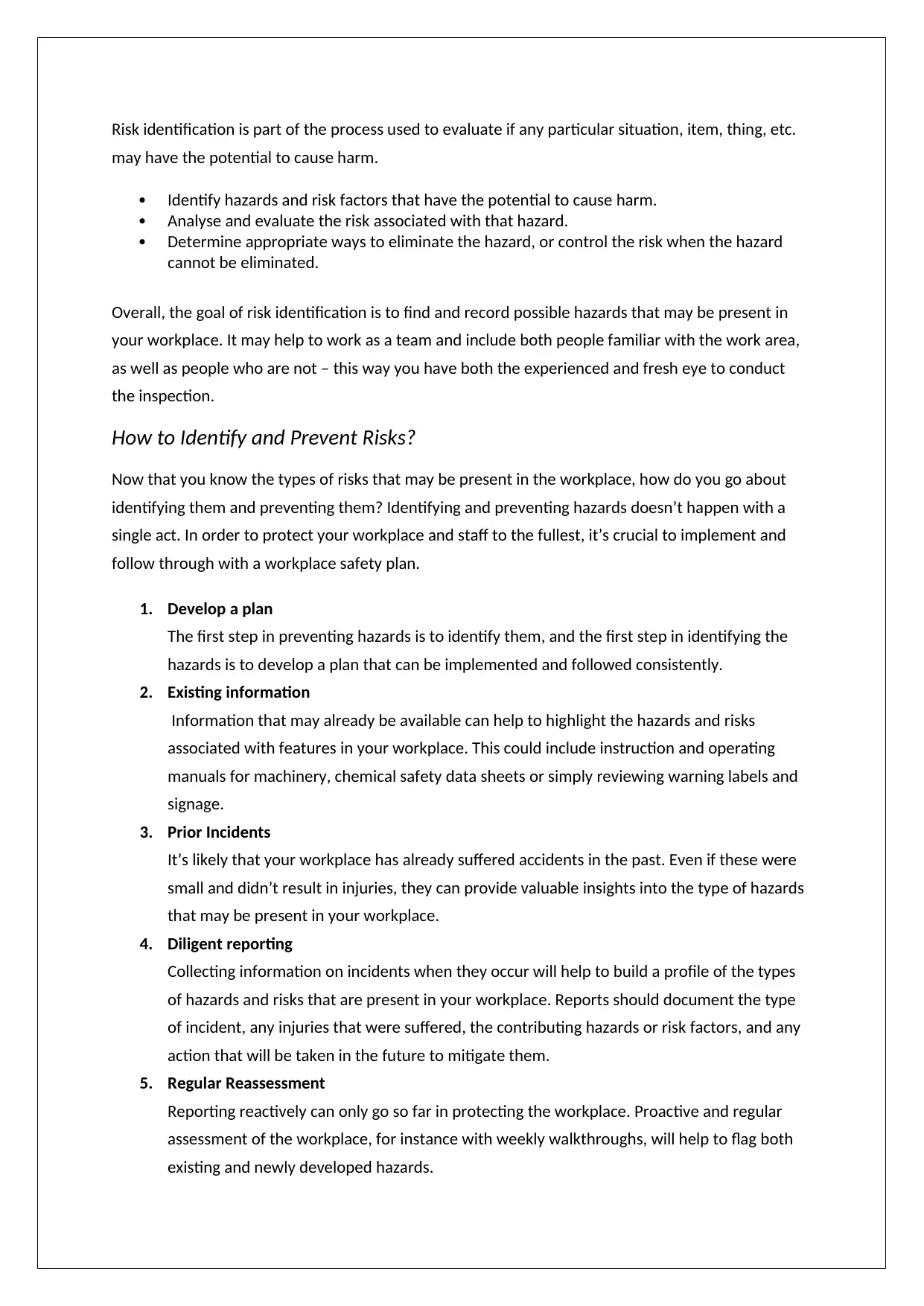
Risk identification is part of the process used to evaluate if any particular situation, item, thing, etc.
may have the potential to cause harm.
Identify hazards and risk factors that have the potential to cause harm.
Analyse and evaluate the risk associated with that hazard.
Determine appropriate ways to eliminate the hazard, or control the risk when the hazard
cannot be eliminated.
Overall, the goal of risk identification is to find and record possible hazards that may be present in
your workplace. It may help to work as a team and include both people familiar with the work area,
as well as people who are not – this way you have both the experienced and fresh eye to conduct
the inspection.
How to Identify and Prevent Risks?
Now that you know the types of risks that may be present in the workplace, how do you go about
identifying them and preventing them? Identifying and preventing hazards doesn’t happen with a
single act. In order to protect your workplace and staff to the fullest, it’s crucial to implement and
follow through with a workplace safety plan.
1. Develop a plan
The first step in preventing hazards is to identify them, and the first step in identifying the
hazards is to develop a plan that can be implemented and followed consistently.
2. Existing information
Information that may already be available can help to highlight the hazards and risks
associated with features in your workplace. This could include instruction and operating
manuals for machinery, chemical safety data sheets or simply reviewing warning labels and
signage.
3. Prior Incidents
It’s likely that your workplace has already suffered accidents in the past. Even if these were
small and didn’t result in injuries, they can provide valuable insights into the type of hazards
that may be present in your workplace.
4. Diligent reporting
Collecting information on incidents when they occur will help to build a profile of the types
of hazards and risks that are present in your workplace. Reports should document the type
of incident, any injuries that were suffered, the contributing hazards or risk factors, and any
action that will be taken in the future to mitigate them.
5. Regular Reassessment
Reporting reactively can only go so far in protecting the workplace. Proactive and regular
assessment of the workplace, for instance with weekly walkthroughs, will help to flag both
existing and newly developed hazards.
may have the potential to cause harm.
Identify hazards and risk factors that have the potential to cause harm.
Analyse and evaluate the risk associated with that hazard.
Determine appropriate ways to eliminate the hazard, or control the risk when the hazard
cannot be eliminated.
Overall, the goal of risk identification is to find and record possible hazards that may be present in
your workplace. It may help to work as a team and include both people familiar with the work area,
as well as people who are not – this way you have both the experienced and fresh eye to conduct
the inspection.
How to Identify and Prevent Risks?
Now that you know the types of risks that may be present in the workplace, how do you go about
identifying them and preventing them? Identifying and preventing hazards doesn’t happen with a
single act. In order to protect your workplace and staff to the fullest, it’s crucial to implement and
follow through with a workplace safety plan.
1. Develop a plan
The first step in preventing hazards is to identify them, and the first step in identifying the
hazards is to develop a plan that can be implemented and followed consistently.
2. Existing information
Information that may already be available can help to highlight the hazards and risks
associated with features in your workplace. This could include instruction and operating
manuals for machinery, chemical safety data sheets or simply reviewing warning labels and
signage.
3. Prior Incidents
It’s likely that your workplace has already suffered accidents in the past. Even if these were
small and didn’t result in injuries, they can provide valuable insights into the type of hazards
that may be present in your workplace.
4. Diligent reporting
Collecting information on incidents when they occur will help to build a profile of the types
of hazards and risks that are present in your workplace. Reports should document the type
of incident, any injuries that were suffered, the contributing hazards or risk factors, and any
action that will be taken in the future to mitigate them.
5. Regular Reassessment
Reporting reactively can only go so far in protecting the workplace. Proactive and regular
assessment of the workplace, for instance with weekly walkthroughs, will help to flag both
existing and newly developed hazards.
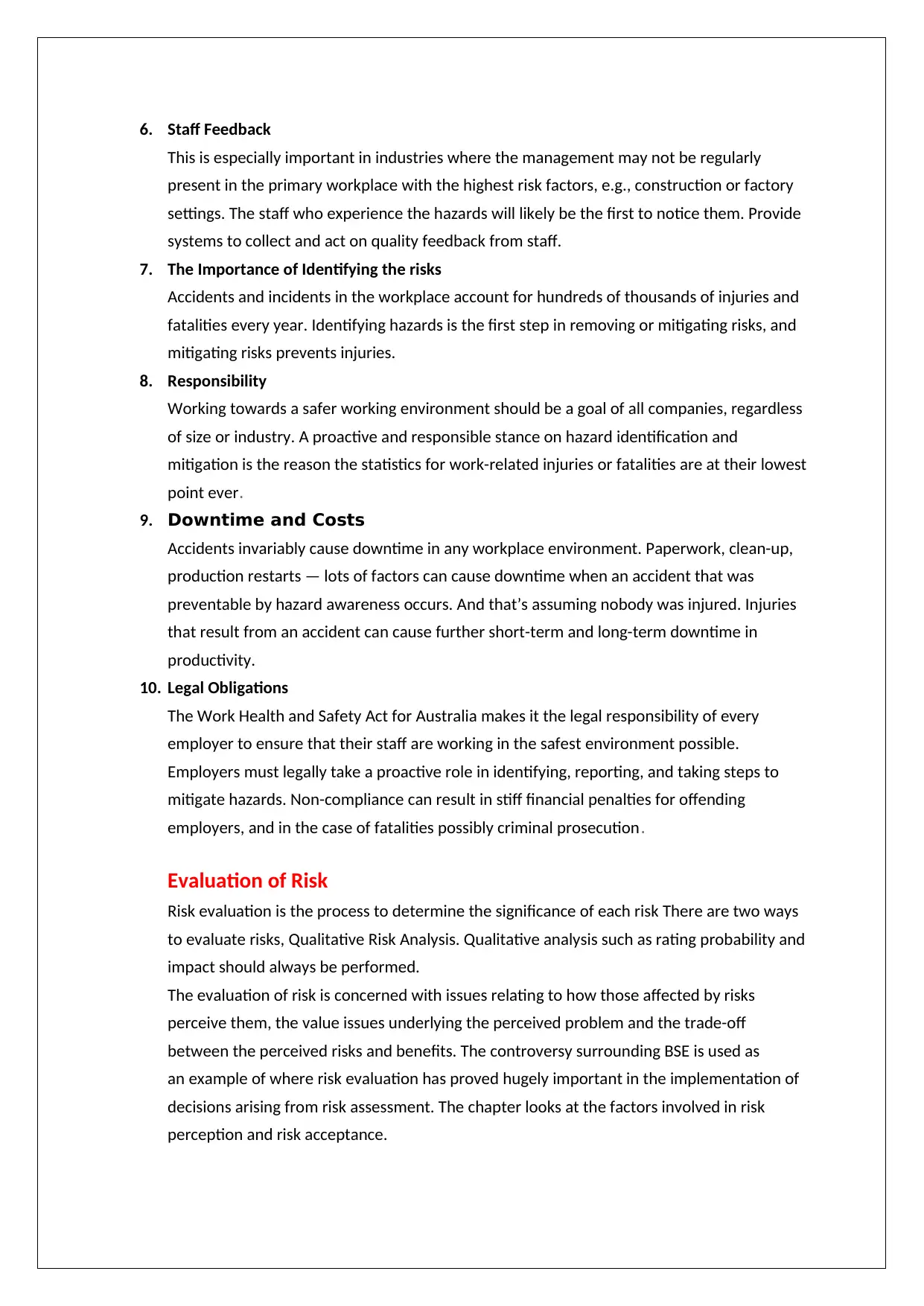
6. Staff Feedback
This is especially important in industries where the management may not be regularly
present in the primary workplace with the highest risk factors, e.g., construction or factory
settings. The staff who experience the hazards will likely be the first to notice them. Provide
systems to collect and act on quality feedback from staff.
7. The Importance of Identifying the risks
Accidents and incidents in the workplace account for hundreds of thousands of injuries and
fatalities every year. Identifying hazards is the first step in removing or mitigating risks, and
mitigating risks prevents injuries.
8. Responsibility
Working towards a safer working environment should be a goal of all companies, regardless
of size or industry. A proactive and responsible stance on hazard identification and
mitigation is the reason the statistics for work-related injuries or fatalities are at their lowest
point ever.
9. Downtime and Costs
Accidents invariably cause downtime in any workplace environment. Paperwork, clean-up,
production restarts — lots of factors can cause downtime when an accident that was
preventable by hazard awareness occurs. And that’s assuming nobody was injured. Injuries
that result from an accident can cause further short-term and long-term downtime in
productivity.
10. Legal Obligations
The Work Health and Safety Act for Australia makes it the legal responsibility of every
employer to ensure that their staff are working in the safest environment possible.
Employers must legally take a proactive role in identifying, reporting, and taking steps to
mitigate hazards. Non-compliance can result in stiff financial penalties for offending
employers, and in the case of fatalities possibly criminal prosecution.
Evaluation of Risk
Risk evaluation is the process to determine the significance of each risk There are two ways
to evaluate risks, Qualitative Risk Analysis. Qualitative analysis such as rating probability and
impact should always be performed.
The evaluation of risk is concerned with issues relating to how those affected by risks
perceive them, the value issues underlying the perceived problem and the trade-off
between the perceived risks and benefits. The controversy surrounding BSE is used as
an example of where risk evaluation has proved hugely important in the implementation of
decisions arising from risk assessment. The chapter looks at the factors involved in risk
perception and risk acceptance.
This is especially important in industries where the management may not be regularly
present in the primary workplace with the highest risk factors, e.g., construction or factory
settings. The staff who experience the hazards will likely be the first to notice them. Provide
systems to collect and act on quality feedback from staff.
7. The Importance of Identifying the risks
Accidents and incidents in the workplace account for hundreds of thousands of injuries and
fatalities every year. Identifying hazards is the first step in removing or mitigating risks, and
mitigating risks prevents injuries.
8. Responsibility
Working towards a safer working environment should be a goal of all companies, regardless
of size or industry. A proactive and responsible stance on hazard identification and
mitigation is the reason the statistics for work-related injuries or fatalities are at their lowest
point ever.
9. Downtime and Costs
Accidents invariably cause downtime in any workplace environment. Paperwork, clean-up,
production restarts — lots of factors can cause downtime when an accident that was
preventable by hazard awareness occurs. And that’s assuming nobody was injured. Injuries
that result from an accident can cause further short-term and long-term downtime in
productivity.
10. Legal Obligations
The Work Health and Safety Act for Australia makes it the legal responsibility of every
employer to ensure that their staff are working in the safest environment possible.
Employers must legally take a proactive role in identifying, reporting, and taking steps to
mitigate hazards. Non-compliance can result in stiff financial penalties for offending
employers, and in the case of fatalities possibly criminal prosecution.
Evaluation of Risk
Risk evaluation is the process to determine the significance of each risk There are two ways
to evaluate risks, Qualitative Risk Analysis. Qualitative analysis such as rating probability and
impact should always be performed.
The evaluation of risk is concerned with issues relating to how those affected by risks
perceive them, the value issues underlying the perceived problem and the trade-off
between the perceived risks and benefits. The controversy surrounding BSE is used as
an example of where risk evaluation has proved hugely important in the implementation of
decisions arising from risk assessment. The chapter looks at the factors involved in risk
perception and risk acceptance.
⊘ This is a preview!⊘
Do you want full access?
Subscribe today to unlock all pages.

Trusted by 1+ million students worldwide
1 out of 16
Related Documents
Your All-in-One AI-Powered Toolkit for Academic Success.
+13062052269
info@desklib.com
Available 24*7 on WhatsApp / Email
![[object Object]](/_next/static/media/star-bottom.7253800d.svg)
Unlock your academic potential
Copyright © 2020–2025 A2Z Services. All Rights Reserved. Developed and managed by ZUCOL.





